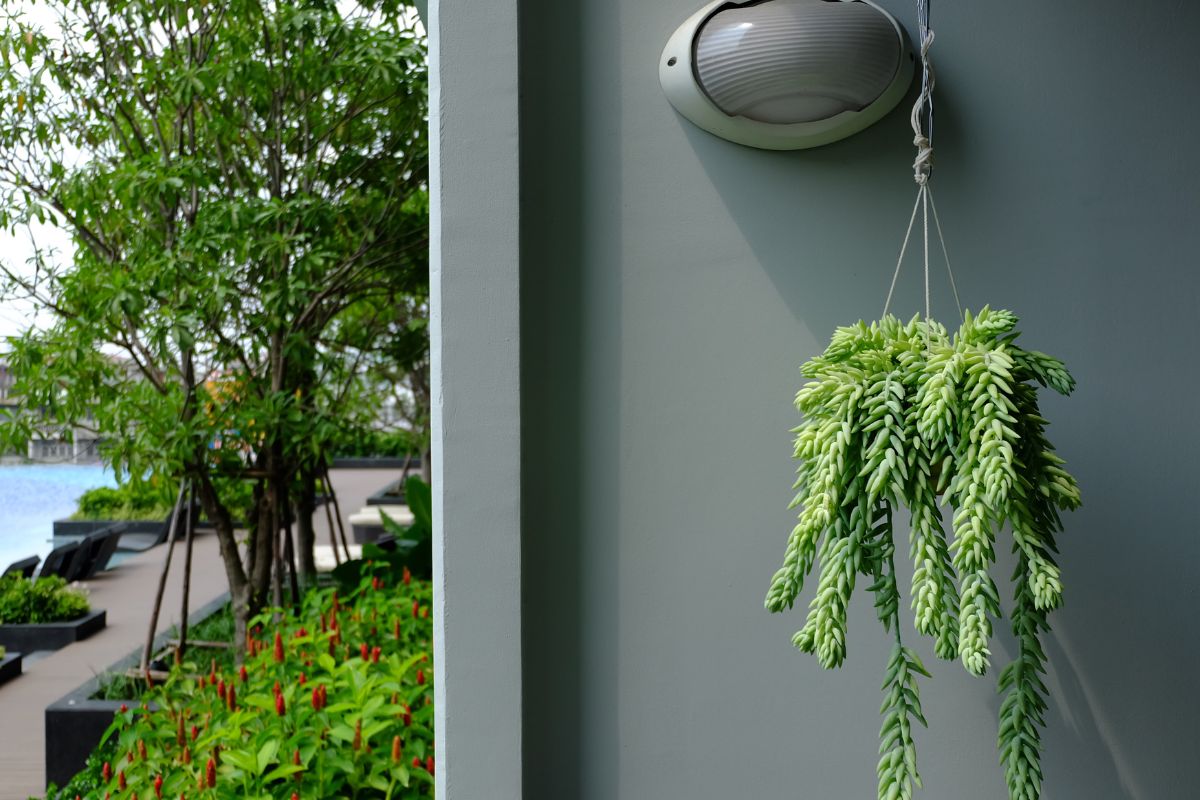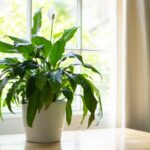Placing an indoor plant on a hanging platform or basket is an incredibly simple and easy way to add a bit more visual flare to any room in the house or the garden, but very often, people will place hanging plants right in front of a window where they can bask in the sunlight.
However, while this certainly allows the plant to look as colorful and appealing as possible, not every plant enjoys remaining in direct sunlight and can experience stunted growth if they’re kept in the heat for too long.

Thankfully, if you live in an area with a cooler climate, there are still plenty of dazzling plants out there that are easy to hang up and care for, and that can remain healthy without needing direct sunlight 24/7, so you won’t have to ditch the idea entirely.
Here are 11 of the most beautiful plants that will thrive when exposed to a minimal amount of light and that shine the most when they are hanging from a ceiling.
1. Chinese Evergreen
The pink patterned leaves of the Chinese Evergreen really help it to stand out from any other house plant, giving it a very expressive look that shines the most during the months of summer and spring.
They are slightly bigger and wider than a lot of plants that are commonly placed on hanging platforms, so it is usually best to try placing 2 or 3 of them, each with enough space between them, rather than bunching a lot of them together.
The Chinese Evergreen will grow at a steady rate when in a low-lit area and will need to be watered far less frequently than if it was placed outdoors, making it very easy to manage.
The key to knowing when it’s time to refresh this beautiful plant is by checking if the top 2 inches of the soil are dry. If so, then it’s time to add an extra drizzle over the top.
Because these plants are considered to be slow-growers, you will only need to start thinking about repotting them after 2 to 3 years, making them even easier to care for.
2. English Ivy
The English Ivy is known for being an incredibly versatile plant, meaning that it can be customized exactly to your liking depending on the aesthetic of the room or garden you’re hoping to place it in.
While you can buy an English Ivy with long and lustrous leaves that can stretch down from a basket, you can also buy much smaller versions that you are able to trim down if you want to keep them neat and tidy.
They are also versatile in the sense that they can adapt to virtually any amount of sunlight.
While they can easily withstand medium to bright light, they will still grow at a steady pace when in low light conditions too, something they are very accustomed to seeing as they are normally found hiding away in dense woodlands.
Just like other ivy plants, the English Ivy doesn’t like wet soil, so always keep in mind that it’s better for it to be too dry than moist and soggy.
During the growing season (spring and summer) the plant should be watered weekly, but when the winter rolls around, start making the watering sessions a little more infrequent.
3. Blue Star-Fern
Blue-Star Ferns look a little more tropical and exotic compared to your average fern plant, and a lot of this comes from the paper-thin blue and green leaves which lend it an incredibly vibrant and unique appearance that helps breathe new life into any room it’s placed in.
It’s no surprise that these ferns have such a peculiar texture and color scheme since they are actually native to the Amazon Rainforest where they are commonly found hanging from trees.
Therefore, these plants are essentially designed to always be hanging from something, especially since their leaves can grow so long and will usually dangle over the center of the plant, especially during its growing season when it can become big and bushy.
These ferns should always be hung in a spot where they are in the shade and aren’t exposed to direct sunlight, but it’s also very important to always make sure the room they are in is fairly humid at all times so that their soil doesn’t end up completely drying out.
Another thing that all owners of this plant should always keep in mind is that the Blue Star-Fern does not enjoy getting its leaves wet, and in some cases, this can even cause a shock which can affect the plant’s growth cycle.
Therefore, during the weekly watering session, always trickle the water down from the sides and try to avoid the leaves as best you can.
4. Marble Queen
If you’ve ever searched up some “hanging indoor plant ideas” before and gone straight to the images, there is a very high chance you have come across the Marble Queen before, a fresh and colorful plant that can be easily cared for and still manages to look incredible.
They are instantly recognizable for their white and light green marbled leaves which are incredibly thin, which is the main reason why they are so sensitive to sunlight since it is very easy for their delicate leaves to become crispy and brown.
Luckily, because of how naturally bright and exuberant these plants already are, they will still lighten up a room even when they are hung up in a shady spot, though it should be known that they will still need at least some indirect sunlight to grow.
As long as you don’t place them on a basket that is exposed to direct sunlight, these delightful plants will easily grow anywhere in the house, and while they enjoy consistent watering, they are also drought tolerant, so don’t worry if you miss the occasional session.
5. Wax Begonia
If you really want to go all-out with a plant that will completely cover a basket or container with a medley of different colors and patterns, you won’t want to miss out on the Wax Begonia, a cascading plant that can live quite happily in low-light conditions.
Because of how gigantic these plants can become, usually growing up to 18 inches high once matured, if you really want to make it look as visually stunning as possible, it’s best to use a smaller container that they can easily dangle over.
With that being said though, you will also need to make sure that the basket is firmly held with multiple chains or ropes, just to make sure the plant doesn’t end up tipping it over.
Once they reach their full bloom between May and October, the plant will begin sprouting pink flowers which add a delicate contrast to the white and red.
The Wax Begonia is very adaptable, so it will quickly feel comfortable when placed in a shady spot with only a minimal amount of light peeking through, and they only require roughly an inch of water each week to receive all the healthy nutrients they need to grow.
6. Pinstripe Calathea
Just as the name implies, this small and delicate plant possesses pink and white pinstripes that run across the wide and rounded leaves, and while it may seem like a fairly basic addition, it fits so well with the atmosphere and vibe of the spring and summer months.
The compact, bush-like shape that this plant takes on makes it so ideal for displaying on a hanging planter or basket, and since they are already used to growing in the shade from being a jungle native, they will still shine brightly even when they’re in the shade.
Their long and tall stems grow upwards and outwards, so they won’t immediately cover the basket as soon as they start growing, making them very suitable for a living room or even the outdoor porch where they can look bright and colorful but still appropriate.
While they enjoy not being oversaturated with light, this plant still needs its soil to be slightly moist at all times since dried-out soil can end up affecting their growth.
On the other hand, the Pinstripe Calathea is very susceptible to root rot, so you also want to avoid overwatering it too.
The best way to keep this plant hydrated without running any risks is to simply water them every 1 to 2 weeks. This is seen as the perfect amount when they are kept in low-light conditions and is enough time for the soil to dry out about halfway between each watering session.
7. Rattlesnake Plant
The elongated leaves, bright green and purple coloration, and dark spotty pattern all come together to make the Rattlesnake Plant a real joy just to look at up close, even when it’s not being enhanced by the beaming sunlight.
At the end of the day, when choosing a plant to hang up either around the house or outside, you want something that is going to look as eye-catching as possible, and you certainly get that with the Rattlesnake.
These plants love to remain moist at all times, so either a light and sandy soil or a potting mix made from two parts peat moss and one part perlite will both be perfect for ensuring the plant remains fresh and hydrated at all times.
It’s still recommended to place this plant on a hanging basket or platform where it can at least be exposed to a moderate amount of sunlight and is far away from any air conditioning units and heating systems so that it doesn’t experience a sudden change in temperature.
8. Creeping Fig
The Creeping Fig is a lesser-known member of the ficus family, which is unfortunate because it is actually one of the most unique plants in terms of its appearance, featuring long vine-like stems along with dainty bright green leaves.
The Creeping Fig can eventually reach up to 15 feet long, which is all thanks to the climbing stems that wrap around any platform or basket they can find, giving off a very natural and agricultural aesthetic.
While you can prune the Creeping Fig if it starts to become a little unbearable in length, try to avoid doing this during the fall or winter since its growth rate will slow down during this time.
Instead, try cutting it down during the early spring, right after it has begun a new growth cycle.
On average, each Creeping Fig plant needs about 6 to 8 hours of diffused, indirect light each day for it to remain healthy, and it should be watered about once a week.
If you start to notice the leaves turning brown, or if they begin dropping from the plant, it’s an indication that it’s being overwatered, so it’s always worth checking the leaves to determine how comfortable the plant is.
9. Nerve Plant
Not all hanging plants need to be big and flashy with lots of foliage covering their pots.
Sometimes, a more minimalistic look can make a plant stand out even more, especially if it also features some wonderful patterns, such as the ones that can be found on the Nerve Plant.
The criss-cross veins that can be spotted on the small and thick leaves of this plant are just enough to help separate it from your everyday fern or ivy.
The plant may also be known for being fairly docile and small, but what a lot of people don’t realize is this is only because Nerve Plants grow incredibly slowly.
In fact, once they have fully developed over the course of a few years, the elegant stems of this plant can reach over 6 inches long, and since they only need to be watered every 2 or 3 days, this is a plant that is so easy to care for, but that also looks better the bigger it gets.
Re-potting can often become a bit of a nuisance when you’re hanging up plants and is a lot trickier than regular re-potting since you will also need to take into account the weight of the plant and how it will affect the surrounding plants too.
If you want to avoid this issue completely and still want a plant that can look gorgeous even while resting in the shade, a Nerve Plant might be just what you’re looking for.
10. Spider Plant
The Spider Plant gets its name from the long and curled grass-like leaves that stretch out from its core, but because of how compact the plant itself actually is, it never looks untidy or messy and actually has a very smart and tidy visual appearance.
This makes it great to hang up in an office, bedroom, or even a bathroom.
Any room that has bright walls and is on the smaller side will be perfect for this plant, especially if the basket you use is also a bright color to complement the deep green and white color of the leaves.
Exposing Spider Plants to direct sunlight can cause some serious damage to their growth and well-being, so providing them with a light shade while they hang from the ceiling will be perfect for them.
Throughout their growing season (spring and summer), the soil they’re planted in needs to remain moist, but you can then reduce watering a little bit when winter arrives.
One or two sprinkles of water twice a week will be plenty through the growing season, but for the winter, this can be cut down to once a week.
11. Donkey’s Tail
You’ll struggle to find a plant that has an appearance quite like the Donkey’s Tail, with slim stems that can reach up to 4 feet that are completely covered in bulbous tear-drop-shaped leaves, it really is a stunning visual that can immediately add some intrigue to a room.
This plant does enjoy basking in partial sun, but full sunlight will burn off the leaves, so keeping it in a bright shady area will be perfect for facilitating its growth and development.
Speaking of growth, considering just how big these wild plants can grow, you probably aren’t going to need more than 2 or 3 of them at a time, otherwise, things can become messy very quickly.
You also need to be careful that the plant isn’t too low to the ground when you hang it up since it will easily reach the bottom in no time and could even become the pet’s next favorite treat, and even though the leaves aren’t toxic, they still aren’t healthy to eat.
Donkey’s Tail plants barely need any water to thrive and will usually be just fine consuming some water twice per month during the spring and summer.
In the winter, drop this down to once a month, and always make sure you’re feeding the plant tepid water since cold water can give it a shock.
Summary
If you want some hanging plants around the house or outside, but you can’t always rely on the weather to be hot and sunny, there’s no need to worry since there are plenty of hangable plants that can be perfectly healthy and still thrive in low-light conditions.
- Best Hanging Plant For Low Light - September 4, 2023
- Best Indoor Plants Florida - August 28, 2023
- Best Plants For Bathroom Smells - August 21, 2023








